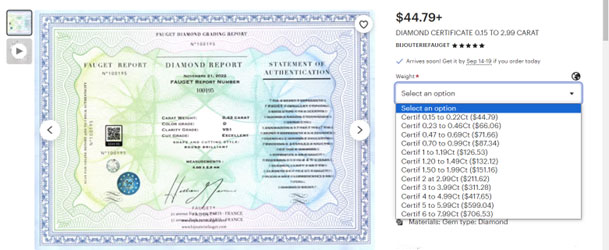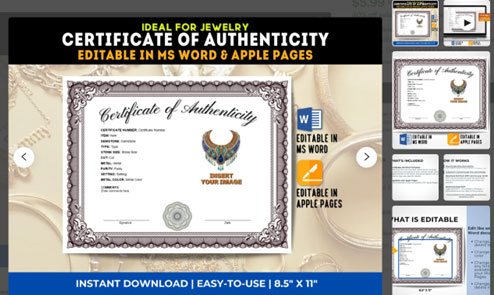Fake diamond certificates – recurring scams and a strange new one
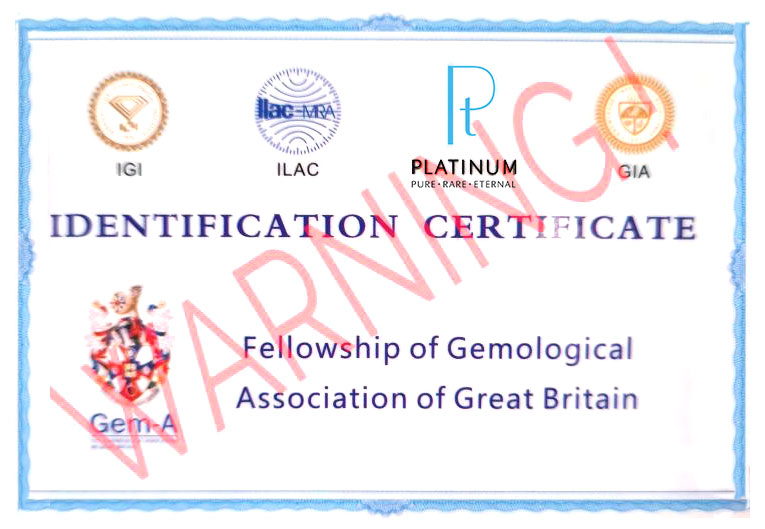 Diamond lab reports, or "certificates," should describe the gem in detail. Retailers provide them, consumers expect them, and insurers rely on them. The catch is, they can't all be trusted.
Diamond lab reports, or "certificates," should describe the gem in detail. Retailers provide them, consumers expect them, and insurers rely on them. The catch is, they can't all be trusted.
Here's a review of some of the most prevalent lab report scams to watch out for, and a strange new one.
First, the new, odd, rather inexplicable one
Over the past several months, members of the public have received packages with jewelry they never ordered: a diamond solitaire ring, in a gift box, along with a laminated "Identification Certificate" describing the ring. The cert (shown above) bears the names and logos of several organizations. Some are recognized gem-grading labs, like the highly regarded GIA. Others are not, such as Gem-A, the Gemmological Association of Great Britain, which is a highly respected organization for gemological education but does not provide any gem-grading services.
The packages went to various addresses in the US, UK and northern Europe. They contained no invoicing or documentation of purchase. The packages bore no clues as to their origin. A number of baffled recipients published their experience on social media. Some contacted the entities named on the cert, but those organizations know nothing about the mysterious jewelry deliveries and did not authorize the use of their names on the certificate.
So what's the scam? That's the tricky part: we don't know yet. Are the gems real or fake? (The card doesn't say the gem is diamond, but it seems at least some recipients assumed it is.) Is the purpose to confuse the public about grading reports? How were the recipients chosen? Did any recipient have the jewelry appraised? Or insured? Is it all just an elaborate prank? Organizations mentioned on the certificate are "monitoring the situation closely"— and insurers should also be aware of it.
Insurers should be alert to possible scams because fraudulent lab reports are not uncommon and can be difficult to recognize. Here are clues to spotting some of the basic frauds.
Following these examples of scams
is a list of reliable labs that we recommend.
Mystery bogus lab
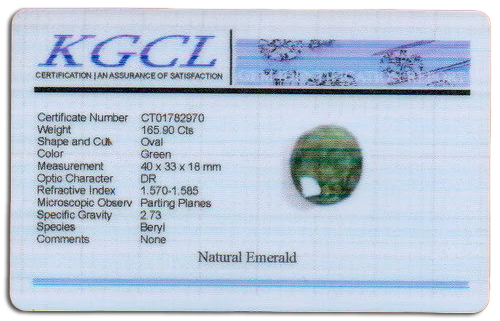 Everyone wants their gem to be "certified," so lots of scammers jump in to fill the need.
Everyone wants their gem to be "certified," so lots of scammers jump in to fill the need.
Many companies and organizations are known mainly by their initials, and that goes for gem-grading labs too, which makes it all the easier for imitators. Just put together some letters on a card and you've got a document – of some sort.
About this document, one innocent consumer commented on an internet forum:
"I found an online forum with some absurdly good deals. They offer a certificate by KGCL that looks a bit sketchy, because a google search turns up nothing for the company."
Serious red flags! Seriously "sketchy!" Do not trust any document—lab report, certificate, appraisal—that does not have name and contact information for the preparer or issuing organization. (Actually, other things about this KGCL "Assurance of Satisfaction" card also make it untrustworthy, but lack of contact info makes it a deal-breaker from the start.)
Make it good-looking
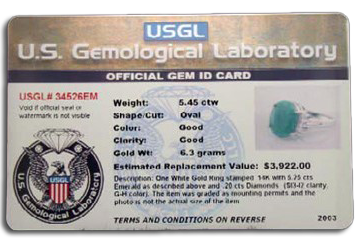 Just because the paper says "laboratory" doesn't mean there is a lab, no matter how good the paper looks. As one gemologist commented, to be a "lab" all you need is a printing press.
Just because the paper says "laboratory" doesn't mean there is a lab, no matter how good the paper looks. As one gemologist commented, to be a "lab" all you need is a printing press.
An authoritative look may help. This named lab has no address and no web presence, but this is an "official" gem card with an "official seal and watermark," along with the official eagle and patriotic-looking shield. Are you impressed?
This card illustrates another thing to watch out for: It has a valuation.
A trustworthy gem-grading lab is a disinterested party. It describes the gem in detail (only the gem, not the setting), but it does not give a valuation. Valuation is the job of an appraiser. That being the case, we might well assume that this card was prepared to the specifications of the retailer, with a valuation meant to convince the purchaser (and insurer) of the jewelry's value.
Piggyback on a name
 Fraudsters might create a document with the name of a real organization slightly misspelled. For example, Gem-A uses the British spelling of gemmological in its name, but the bogus cert at the top of this page spells gemological the American way, with one "m".
Fraudsters might create a document with the name of a real organization slightly misspelled. For example, Gem-A uses the British spelling of gemmological in its name, but the bogus cert at the top of this page spells gemological the American way, with one "m".
Piggyback on a web address
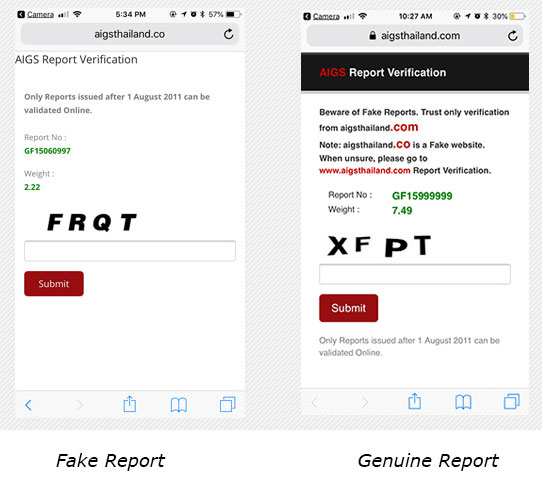 Scammers also alter web addresses to lure visitors who may accidentally misspell when typing. The faux site even mimics the look of the original. This is becoming so problematic that some companies warn customers to be extra careful.
Scammers also alter web addresses to lure visitors who may accidentally misspell when typing. The faux site even mimics the look of the original. This is becoming so problematic that some companies warn customers to be extra careful.
In this case, the paper report had a QR code for accessing online verification. Two screenshots show the scam. Notice the URLs at the top of each page (which you can see by clicking for an enlargement): the fake report directed users to AIGSThailand.co rather than to the genuine site AIGSThailand.com.
The website for the genuine report has a warning about fraudulent certs, but consumers who are sent to the fraudulent site will probably never see the warning.
Make a diamond to match a report
A report from a respected grading lab like GIA describing a high-quality diamond is a good start for this fraud.
When GIA examines a diamond, it issues a report and inscribes the report number on the girdle of the stone. GIA's grading lab has been receiving lab-made diamonds fraudulently inscribed with report numbers of mined diamonds previously graded by GIA. The submitted diamonds were lab-grown and cut to match almost exactly the specs of the mined diamonds they were imitating.
In 2021 police in India uncovered such an operation, perpetrated by a diamond trader. They also seized genuine and fake GIA reports, along with a laser inscribing machine used to put fraudulent GIA report numbers on lab-made and treated diamonds.
Since most jewelers and appraisers do not have the equipment needed to recognize lab-grown gems, lab-grown diamonds with fake GIA report numbers could easily pass into the market as mined stones.


(Number is abreviated for privacy)
The scam can have serious effect, since lab-created diamonds have a much lower valuation than mined diamonds. It's especially insidious because a single authentic report number, verifiable on GIA's site, could be fraudulently inscribed onto many stones of much lower value—whether the bogus stones were lab-made, of poor color quality, clarity-treated, or even CZ or just plain glass.
Best practice for insurers (and consumers!): If the GIA report did not come directly from GIA labs or from a reputable jeweler, it's advisable to have the gem reexamined by GIA. If GIA finds the stone does not match the report number, the lab will obscure the fraudulent number and engrave the stone with the number of its new report.
Suppose you're planning a scam
How easy is it to get a cert for that stolen jewelry that came your way or those rings with CZ stones that you'd like to pass off as diamond? You can find everything on the web these days.
Here's a report for a high-quality diamond in the size of your choosing:
Or, fill in the blanks with this one:
Reliable Gem-Grading Labs
All lab reports are not equal! Besides the completely bogus labs, there are also grading labs that are known to inflate gem quality. There are labs that "certify" gems a gemologist has never examined; labs that will produce certs to the jewelry retailer's specifications; reports prepared by the retail jeweler that "prove" the very bargain the selling jeweler verbally promised. It's the Wild West out there in lab-land.
We recommend the following labs, not because we are tied to them in any way but because they have a track record for accuracy in grading.
Use these links to verify all reports you receive. If you don't have this page handy at the time, just go to the lab's website, where the verification link will be obvious. Note that we are not printing pictures here because the layout of lab reports may change over time. Best practice is to verify the report by checking online.
Gemological Institute of America GIA Report Check
American Gem Society AGS Report Verification
Gem Certification and Assurance Lab GCAL Certificate Search
When the report comes up, don't just glance at it. To verify a report, check that the descriptive information—carat weight, gem measurements, color and clarity—on the screen matches the information on the report or appraisal you have. You want to be sure the report describes the gem you are insuring.
FOR AGENTS & UNDERWRITERS
A lab report is only as good as the lab that issues it. Names of reliable grading labs, unreliable labs, and completely bogus labs can sound much alike, and their initials are even more confusing. Don't be taken in by the alphabet soup of certs out there.
Some organizations have the word laboratory in their name, but do not mistake a "certificate of authenticity" or "assurance of excellence" or any such paper for a report from a gem-grading lab.
A document or gem card supplied by the jewelry retailer may look impressive, but if it has a valuation it is basically a sales tool. Ask for a lab report from one of the reliable grading labs listed above.
All high-value gem jewelry should have a report from a reliable gem-grading lab, inaddition to an appraisal. A lab report describes only the gem; an appraisal describes the gem and the setting, and gives a valuation.
Be especially cautious insuring jewelry purchased on the secondary market — eBay, Craig's list, flea markets, friend, etc.—or from auction sites or shopping networks, or in tourist areas during travel. The documents are likely to be unreliable.
If the report was prepared by the selling jeweler, consider asking for a report from one of the respected labs.
FOR ADJUSTERS
Compare data on all documents — appraisal, diamond report, and sales receipt — to be sure descriptive information agrees.
Compare the valuation with the purchase price, if available.
©2000-2024, JCRS Inland Marine Solutions, Inc. All Rights Reserved. www.jcrs.com

